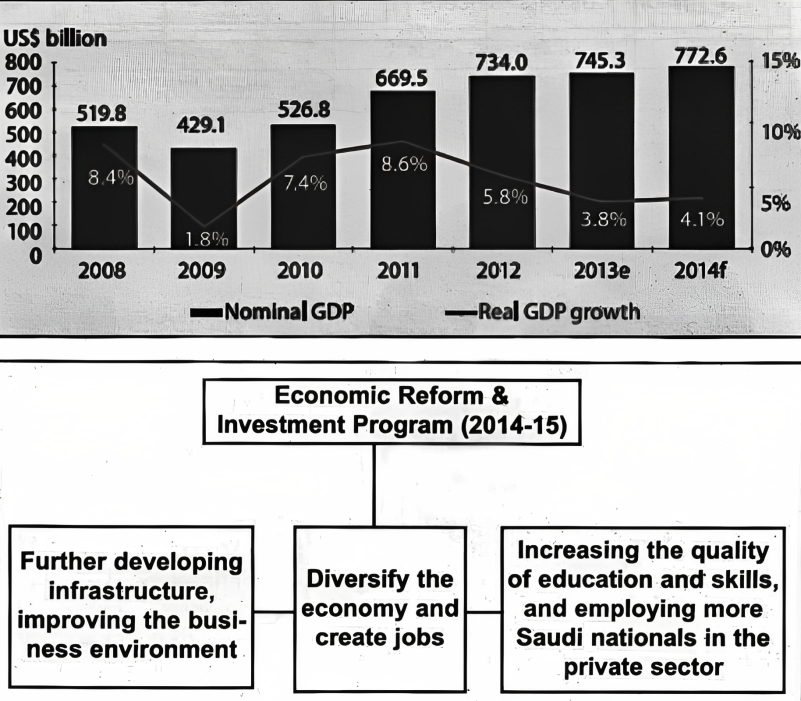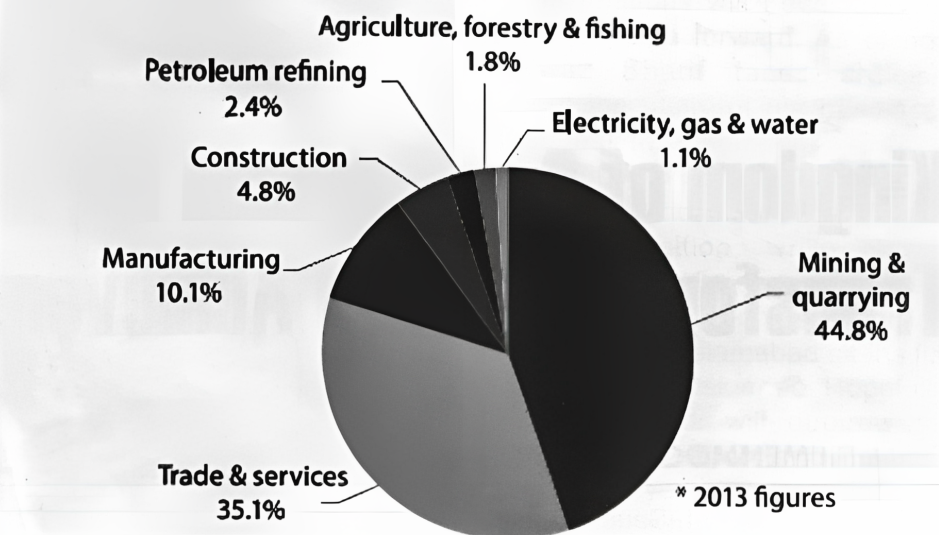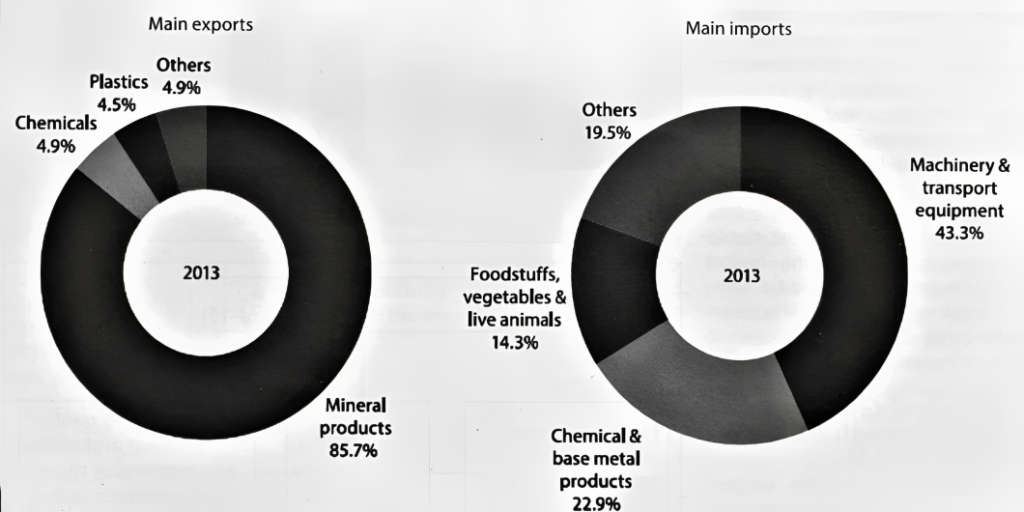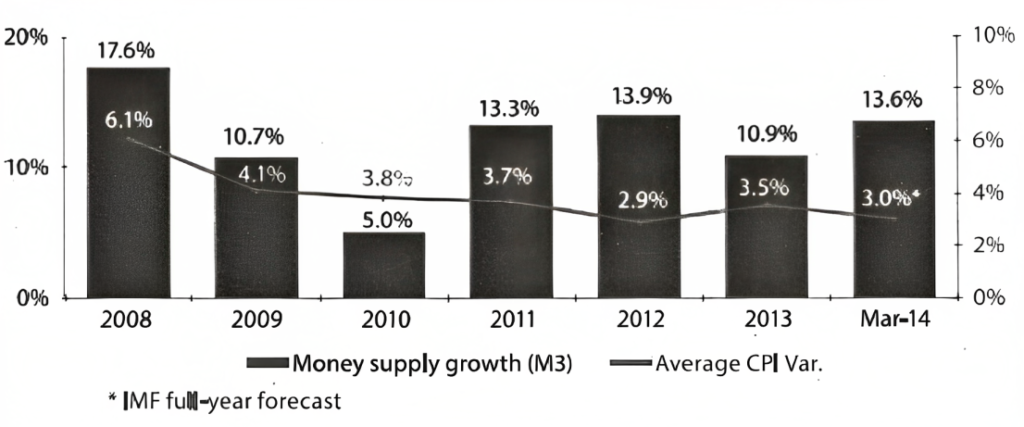The Kingdom of Saudi Arabia plays a crucial role in global and regional economic development. It is a leading player in strengthening partnerships with Arab bilateral and multilateral partners for development assistance and scaling up support for countries in transition in many parts of the world. Despite weak global economic conditions and ongoing financial crunch, it is one of the fastest and most stable economic growth patterns in the world. Undoubtedly it holds a spiritual, economic, and political position that is rarely seen, and is respected all over the world.
Nominal GDP and Real Growth Rates (2008-2014)
Saudi Arabia is the largest economy in the Gulf Cooperation Council (GCC) and Middle East and North Africa (MENA) and of course an active member of the G-20. It has been one of the major shareholders in so many generous humanitarian programs in the world which has successfully turned tears into smiles. Moreover, it also plays an important role in regional and global economic development as a major source of energy, overseas development assistance, foreign direct investment and remittances.
Its miraculous socio-economic, massive geo-political and geo-strategic transformations are a result of the strategies that have been implemented since the rule of its founder King Abdulaziz Al Saud until today under the rule of the Custodian of the Two Holy Mosques His Majesty King Abdullah ibn Abdulaziz.
According to International Monetary Agency (IMF) latest report (May, 2014), economic growth in Saudi Arabia would be above 4 percent during 2014-15 because of government spending and robust private sector activity. Furthermore, inflationary pressure would be subdued.
It also progresses to further reform the annual budget, introduce a medium-term budget framework, and develop tools to manage the volatility of oil revenues during 2014-15.

Economic Diversification
The government of Saudi Arabia has diversified its macro-economy through power generation, telecommunications, natural gas exploration and petrochemical sectors. To attract foreign direct investment, the country acceded to WTO in 2005. It is carrying a multi-billion dollar development strategy to build six Greenfield economic cities and industrial zones in the country. By 2020, the industrial cities will generate USD 150 billion in GDP and create 1.3 million jobs. Its sincere efforts to shift from an oil-based economy to a knowledge-based economy are substantiated by the record non-oil exports in 2013. Export oriented policies achieved current account surplus.
It is derived economic diversification to shift away from a volatile oil-centric economy. Now, it has the potential to reduce the impact of any future international financial crises, and is also creating significant investment and financing opportunities. Recent announcements such as increase in the use of unconventional gas supplies, solar energy adoption, and introduction of nuclear and renewable energy are value-addition. The diversification of its economy has increased the net foreign assets by nearly $166 billion in 2012 and the funds are set to surpass $one trillion in 2015 for the first time in the Kingdom’s history.
The IMF projected the assets, controlled by the Saudi Arabian Monetary Agency (SAMA), central bank, to smash the $one trillion barrier for the first time to peak at an all-time high of $1,058 trillion at the end of 2015. It is expected for the assets to further swell to $1,128 trillion at the end of 2016 and break another record of $1,213 trillion at the end of 2017.


Dividends of 10th Development Plan (2013-14)
Saudi Arabia controls about 17 percent of the world’s proven petroleum reserves. Since 1970s, the government sponsored five-year development plans control the economic policy framework of the country, with fiscal policy taking a central role, and thereby creating a strong link between fiscal spending and economic activity. The government’s fiscal policy is geared towards development objectives: investment in social and economic infrastructure, economic diversification, and achieving macroeconomic stability.
Saudi Arabian 10th development plan concentrated more on the quality of the spending, the quality of the deliverables and the quality of the services that are provided to its people. It took new qualitative measures to improve its economic development, signaling a potential shift of emphasis in its drive to raise living standards by spending tens of billions of dollars on welfare.
According to a latest report by International Data Corporation (IDC), Saudi Arabia’s healthcare IT market is forecast to rise by 11 percent annually and is one of the fastest growing markets in the world. IT spending in Saudi Arabia is due to modernization and expansion of hospitals and clinics as the country looks to increase its bed capacity to 30,000. Due to which healthcare is also the second fastest growing sector after government in terms of IT spending. The report also predicts that IT support services will be the fastest growing service areas in the country.
Saudi Budget 2014
Saudi Arabia announced its 2014 budget which is a balanced budget of $228 billion. This is the sixth budget since the global financial crisis. It adopted the expansionary path. Education, health and infrastructure received major allocations of the budget. Government expenditure rose in 2013 to $247 billion, an increase of 15 percent over 2012. Spending went over budgeted outlay by about 13 percent.
Saudi gross domestic product (GDP) registered a record level of $745 billion in 2013, by far the largest GCC and Arab economy, making it the 19th economy in the world in GDP size, ahead of Switzerland, Sweden, Norway and Iran.
Due to rigorous diversification of economy, oil GDP in fact declined in 2013 by nearly four percent, while non-oil sector grew by over 9 percent. The healthy growth in the private sector moderated the impact of the oil sector decline, pointing again to the significance of economic diversification and the need for encouraging the private sector to have a larger share in the GDP. When that happens, the private sector would be able to better cushion the impact of volatile oil prices.
Over the past eight years (2006-2013), Saudi Arabia has spent over $1.36 trillion in its general budgets, plus scores of billions more in special additional programs. It is planning to spend another $228 billion during 2014. During those years, it launched thousands of projects. In 2013 alone, the Ministry of Finance reviewed 2,330 projects valued at $48 billion.
With so many projects started, administrative and technical capacities of both government agencies and the private sector have been stretched to the limit and beyond. As a result, hundreds, perhaps thousands, of project are running behind schedule.
| Economic Indicators | 2011 | 2012 | 2013 | 2014f | 2015f |
| Nominal GDP ($bn) | 669.6 | 727.2 | 742.5 | 768.9 | 806.9 |
| GDP Per Capita ($’ 000) | 23602.4 | 24789.9 | 24477.6 | 24516.6 | 24901.2 |
| Real GDP (% change) | 8.6 | 5.1 | 5.8 | 4.6 | 4.5 |
| Non-Oil GDP | 7.7 | 5.0 | 4.8 | 4.2 | 3.9 |
| Commercial bank deposit (SR bn) | 1103.6 | 1215.0 | 1390.8 | 1571.6 | 1760.2 |
| (% change) | 12.1 | 10.1 | 14.5 | 13.0 | 12.0 |
| Inflation | 3.7 | 2.9 | 4.0 | 4.1 | 4.2 |
| Current a/c balance (SR bn) | 15.9 | 177.4 | 123.1 | 93.3 | 73.0 |
| Imports (-) | 97.4 | 120.0 | 141.8 | 152.7 | 163.3 |
| Current account (percent of GDP) | 12.7 | 23.7 | 22.4 | 17.9 | 15.4 |
| SAMA’s net foreign assets | 440.4 | 535.2 | 647.6 | 716.7 | 768.5 |
EU GCC Invest Report (2013-14)
According to this report the Kingdom of Saudi Arabia outperformed other GCC and attracted a record inflow of FDI during 2013-14. A friendly business environment and political stability played very important role in attracting FDIs. In the “Ease of Doing Business Ranking”, Saudi Arabia performs in the top 10 in four out of 10 measured categories. Registering Property (1st), Dealing with Construction Permits (4th), Starting a Business (10th) and Paying Taxes (10th) are the strong competitive advantages of Saudi Arabia. But even the otherwise often underdeveloped categories in the region like Investor Protection (17th) and Getting Credit (48th) can be seen as strengths.
Even the IM admits that Saudi Arabia continues to play a systemic role in stabilising the global oil market, which contributes positively to the global economy. Regionally, Saudi Arabia is a generous provider of financial assistance to other countries, while remittances sent home by expatriates working in the country are an important source of income for many nations.
Furthermore, monetary and macro prudential policy settings are appropriate. Equity prices have risen strongly over the past year. The introduction of a formal macro prudential framework would strengthen the financial stability framework in the country.
Growth is projected to pick up to 4 .6 percent in 2014. Private sector growth is expected to remain strong, and oil production is expected to be little changed from 2013. Large scale infrastructure projects and spending on housing will continue to support non-oil sector growth. Inflation is expected to remain subdued.
Comparative study of IMF report shared that Saudi economy grew strongly by 4 percent in 2013, owing to robust growth in the non-oil private sector. The unemployment rate of nationals fell over the past year, especially among women. Inflation has eased to 2.7 percent in May 2014, largely reflecting lower food price inflation in line with international trends. Credit growth also eased but remained at robust levels. The macro-economy has not been affected by global financial market volatility, and the banking system is well capitalized and profitable.
The Saudi population is young, vibrant and increasingly well-educated and as it continues to enter its working-age years there is tremendous opportunity to boost growth and raise living standards further in the days to come.
Oxford Business Group (OBG) in its latest report (July, 2014) highlighted that Saudi Arabia’s drive to create a more open business environment and broaden its economic base had generated a new audience of investors looking for information and data on the Kingdom. It further diversified economy and encouraged SME. It also developed its equity market. It expanded its key non-oil industries, such as logistics, heavy industry and retail. It introduced many meaningful reforms in its banking, financial and insurance sectors during 2013-14 and now those are paying their dividends. It boosted its foreign direct investment by liberalizing the Kingdom’s capital markets. Improved access to raw materials played in attracting new international investors to lighter segments of industry.
It is predicted that Saudi Arabia’s landmark decision to open its $550 billion stock market to direct investment by foreign institutions will have far reaching positive implications for the whole region by significantly boosting the Middle East North African profile in MSCI emerging markets benchmark.
One imminent impact of the long-awaited Saudi reform drive is that MSCI a free-float adjusted market capitalisation weighted index that is designed to track the equity market performance would be prompted to re-classify the world’s largest oil exporter as an emerging market, which could lead to as much as $40 billion of foreign cash entering the market. Standard & Poor’s estimates that the number of listed companies in Saudi Arabia 1s expected to increase between 250 and 300 between now and 2020.

Performance of Macro-Economy 2013
According to data of the Ministry of Finance, the Kingdom registered a real surplus of SAR 180.3 billion (6.5 percent of GDP) in its budget during 2013. The public debt fell to SAR 75.1 billion (representing 27 percent of GDP) Moreover, the Kingdom achieved a surplus of SAR 486.8 billion (17.4 percent of GDP) in the current account of the balance of payments (compared to 22.4 percent in the preceding year). The inflation rate increased from 2.9 percent in 2012 to 3.5 percent in 2013 However,it is still under control According to the latest data of the Central Department of Statistics and Information, the inflation annual rate declined to 2 8 percent during February 2014, given that the inflation rate in emerging and developing economies was estimated at 6.2 percent in 2013 Inflationary pressures in the Kingdom were due to the housing sector and food prices.

Credit Ratings
At the time when a number of industrial countries are witnessing a decline in their credit rating, Fitch Credit Rating Agency promoted the Kingdom’s sovereign credit rating from (AA-) to (AA) with a stable outlook, strengthening confidence in our national economy and making it more attractive to investments.
Banking Industry (2013-14)
According to the latest Saudi chart book from Jadwa Investment, total bank deposits in the Kingdom hit a new all-time high above SR 1.5 trillion for the first time in July Bank deposits climbed by 1.7 percent in July to cross the SR1.5 trillion mark.
This lifts the year-on-year growth rate to 14.5 percent, the fastest in the last 12 months. The increase in deposits in July reflects a steady rise in private sector deposits as well as a seasonal spike in public sector deposits, said the Jadwa chartbook for September 2014.
It says that banks remain highly liquid, with deposits at the Saudi Arabian Monetary Agency (SAMA) beyond the statutory requirement rising to a four-month high of SR78 .4 billion at end-July
Domestic banks continued to play their roles in serving the national economy in accordance with latest secure technologies in the banking services field. Monetary base (M3) increased by 10.8 percent 1n 2013 (by 12.8 percent in January of this year) Credit extended to the private sector went up by 12.1 percent to SAR 1,076.4 billion in 2013 (by 12.3 percent in January of this year). Domestic banks maintained their good financial solvency, recording a capital adequacy ratio of 17.9 percent at the end of 2013.
The number of domestic and foreign banks operating in the Kingdom currently is 23, 12 of which are domestic and 11 are foreign which became 12 after licensing the Industrial and Commercial Bank of China (ICBC) in 2012. Driven by the aim of achieving a better spread and service to a larger portion of citizens and expatriates, bank branches operating in the Kingdom grew up by 4.2 percent (72 branches) to 1,768 branches at the end of 2013. The number of ATMs stood at 13,883, increasing by 9.2 percent (11,71 machines) at the end of 2013 compared to 2012. At the same time, POS went up by 16.5 percent to 107,783.
Social Development
Educational development has been one of the main focuses of its social transformation. Custodian of the Two Holy Mosques King Abdullah has approved a five-year plan worth more than SR80 billion to overhaul the Kingdom’s education system. The plan includes building 1,500 nursery schools, training about 25,000 teachers, and establishing educational centers and other related projects.
Huge scholarship program that enables students to study abroad paid great contribution in its overall qualitative educational development. It was founded by His Majesty King Abdullah, and its fruits will produce a huge positive advancement in Saudi society. The number of Saudi government run universities has also now increased to 25, which have been provided with the best academic and material support to perform at the highest levels. The King Abdullah University of Science and Technology (KAUST) and Princess Nora bint Abdulrahman University (PNU) are achieving high standards of research, knowledge and practical learning.
Saudi Arabia’s Anti-Terror Efforts
Establishment of international center for counter terrorism is a great victory for Saudi Arabia which also endorses its strong commitments to fight against terrorism. Initially 10 million dollars was donated by the Kingdom to start the project. His Majesty King Abdullah recently donated a further 100 million dollars to the center as part of the Kingdom’s efforts in actualizing international peace and security and in having a shining record of generosity and achievement in counter-terrorism work.
Earlier this year, it began a pronounced campaign to discourage citizen support for terrorist organizations and other groups that were unpalatable to the government. A new law was decreed by King Abdullah in February, 2014 criminalizing various forms of support to certain groups. Subsequently, the Islamic State of Iraq and al-Sham (ISIS), Jabhat al-Nusra and al Qaeda’s Syrian affiliate were declared terrorist.
The above table clearly shows that Saudi Arabia has been spreading the culture of dialogue between Muslims, and between Muslims and non-Muslims, both regionally and internationally which is distinctive of the Saudi direction in society.
Saudi Arabia on the Political Map
Saudi Arabia’s balanced foreign policies and its sincere efforts in maintaining peace and security in the GCC, MENA and around the world and its strong political commitments towards solving regional conflicts and helping struggling people affected by disasters, has affirmed its central and rather important role on the regional and global political map. It principally played reconciliatory role in Bahrain, Oman, Jordan, and “Morocco and succeeded to save these countries from political turmoil, economic meltdown, ethnic division and the last but not the least, foreign aggression and infiltration. Saudi Arabia through financial and diplomatic means arranged a peaceful transition of power in Yemen and Libya. It also helped Tunisia, Egypt and Pakistan to overcome their difficult times in the near past. Saudi Arabia has also denounced the brutal Israeli aggression on the Palestinians in Gaza and has urged the UN Security Council and the Human Rights Council to realize their responsibilities and apply the Fourth Geneva Convention against Israel to stop its crimes and atrocities against the Palestinian people.
Its rigorous diplomatic efforts and massive humanitarian programs in Syria is high appreciable. It is also leading role in the further strengthening of GCC unity. Most recently, Saudi Arabia diplomatically enhanced its ties within GCC in order to tackle the emerging socio economic obstacles, geo-political trends and geo-strategic issues in and around the region.
Most recently, Saudi Arabia moved to settle differences with Iran and has invited the Iranian foreign minister to Riyadh for the first senior meeting between the two countries. The Saudi foreign minister, Saud al Faisal, contacted his counterpart in Tehran on after months of lower level communications between the countries, aiming to bring an end to a series of regional crises in which both are invested, principally in Syria.
| Kingdom of Saudi Arabia | Diversified Efforts |
| The King Abdullah Bin Abdulaziz International Center for the Arabic Language | Language The King Abdullah International Medical Research Center |
| King Abdullah Bin Abdulaziz International Centre for Interreligious and Intercultural Dialogue | Different inter-faith harmony and dialogue conferences and seminars |
Concluding Remarks
The Kingdom of Saudi Arabia, largest economy in the GCC and MENA always plays a very important role in the peace, harmony and stability of the region and world alike. It is seriously advocating having GCC joint security shield, energy cooperation, food security, joint strategy against terrorism, extremism.
It is also an active member of G-20 and plays its supportive role through international assistance and easy and smooth supply of oil. Now, Saudi Arabia is one of the fastest growing markets in built-assets among the world’s 30 highest grossing countries in the world.
The Kingdom of Saudi Arabia is well known for its generous humanitarian assistance, diplomacy, conflict resolution and reconciliation spirits throughout the world. In religious terms it stands for brotherhood, charity and divine revelations. It has been icon of the Muslim ummah and Muslim nations the world over since its inception because of its friendly and supportive policies towards the socio-economic prosperity and political unity.
Its strong political commitments to fight against terrorism are appreciable. Its interfaith dialogue, tolerance, and cultural diplomacy are making bridges of better understanding,
oneness and togetherness about others around the globe.
Its health and education improved a lot over the last years. If these areas are strengthened, in addition to fostering a more efficient labor market, Saudi Arabia will be able to maintain its competitive edge in the years to come.



